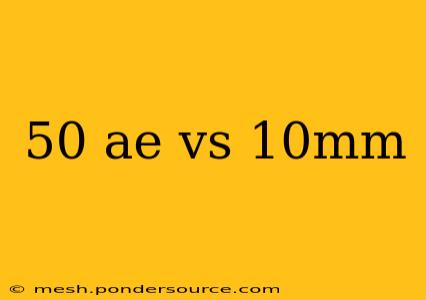Choosing the right handgun cartridge often comes down to a careful consideration of several factors: power, accuracy, recoil, and intended use. For those considering powerful semi-automatic handgun rounds, the .50 Action Express (AE) and 10mm Auto frequently top the list. This in-depth comparison will explore the key differences between these two potent cartridges, helping you make an informed decision.
Power and Ballistics: A Tale of Two Titans
Both the .50 AE and 10mm Auto pack a considerable punch, but their performance characteristics differ significantly. The .50 AE, as its name suggests, boasts a significantly larger diameter bullet, resulting in substantially greater stopping power. It delivers considerably higher energy levels at the muzzle, making it an effective choice for large game hunting or situations demanding immediate incapacitation.
The 10mm Auto, while less powerful than the .50 AE, still offers impressive stopping power for self-defense and hunting smaller game. Its higher velocity compared to the .50 AE, however, contributes to flatter trajectory and better accuracy at longer ranges. This makes it a more versatile option for situations requiring precision shots.
Key Ballistic Differences Summarized:
| Feature | .50 AE | 10mm Auto |
|---|---|---|
| Caliber | .50 inch (12.7 mm) | 10mm (.3937 inch) |
| Muzzle Energy | Significantly Higher | Lower |
| Recoil | Substantially Higher | Noticeably Less |
| Velocity | Lower | Higher |
| Accuracy (General) | Can be less accurate at longer ranges | Generally more accurate at longer ranges |
Recoil and Controllability: A Matter of Management
The .50 AE's considerable power translates to significant recoil. This makes it challenging for many shooters to control, especially during rapid fire. While experienced shooters can manage the recoil, novices might find it difficult to maintain accuracy and target acquisition. The heavier weight of firearms chambered in .50 AE can partially mitigate this, but substantial recoil remains a defining characteristic.
The 10mm Auto, on the other hand, offers more manageable recoil. While still powerful, it allows for faster follow-up shots and improved accuracy during rapid firing sequences. This makes it a better choice for situations requiring multiple shots or sustained engagement.
Availability and Cost: Practical Considerations
Ammunition for both cartridges is available, but the .50 AE tends to be less common and often more expensive than 10mm Auto ammunition. This can impact the overall cost of ownership and training, making the 10mm Auto a more economically viable option for regular practice and range use. Finding a broader selection of .50 AE ammunition, especially different bullet weights and types, might also prove more challenging.
Intended Use: Defining Your Needs
The ideal choice between .50 AE and 10mm Auto hinges on your intended use. The .50 AE's raw power makes it suitable for large game hunting and situations where maximum stopping power is paramount. However, its substantial recoil and limited availability make it less ideal for everyday carry or competitive shooting.
The 10mm Auto’s balance of power, accuracy, and manageable recoil makes it a more versatile round suitable for self-defense, hunting smaller game, and target practice. Its wider availability and lower cost also contribute to its practicality.
Conclusion: The Right Cartridge for the Right Job
Ultimately, the "better" cartridge depends entirely on your individual needs and priorities. The .50 AE offers unmatched stopping power for specific applications, but the 10mm Auto delivers a superior combination of manageable recoil, accuracy, and versatility for a broader range of uses. Careful consideration of your intended use, experience level, and budget is crucial in making the right choice.

